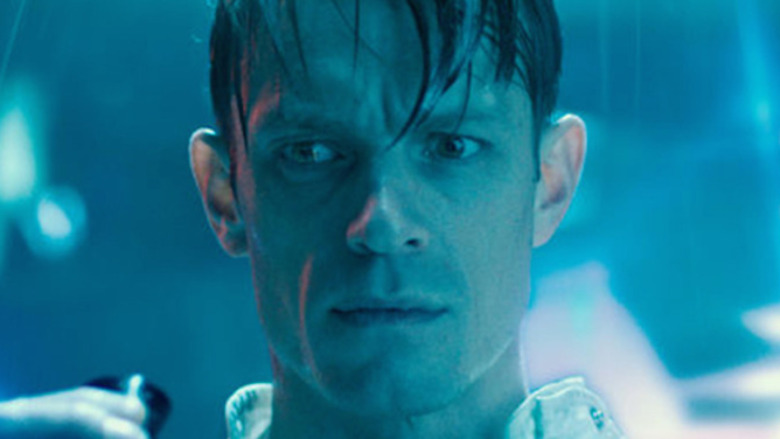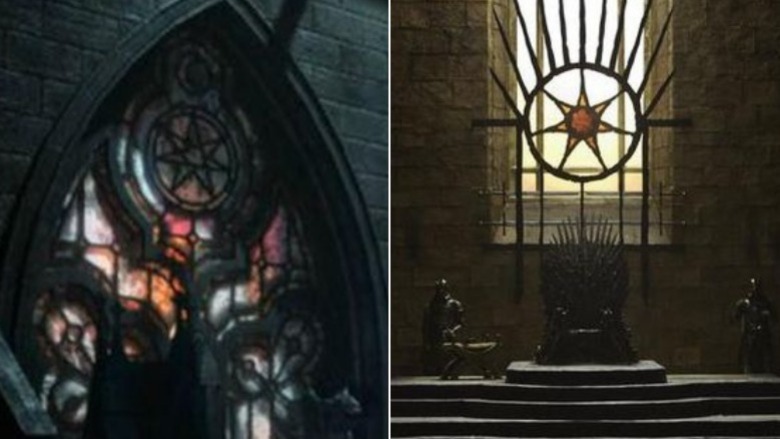Why The Seven-Pointed Star On Altered Carbon Looks So Familiar
At one point, Netflix's "Altered Carbon" seemed poised to be TV's next big genre sensation. Developed by "Alita: Battle Angel" co-scribe Laeta Kalogridis from Richard Morgan's highly popular sci-fi series, the show was a triumph of production and worldbuilding. It follows the twisty tale of a murder investigation in an enthralling dystopian world where human consciousness can be transferred from one body — or "sleeve" — to another. Season 2 got even bigger and better and won over many new fans, but sadly the show's viewership couldn't sustain the sheer scale of production, and Netflix canceled it after two seasons.
Still, the visual and conceptual richness of "Altered Carbon" is such that there's plenty for fans to dig into — even years after the final season aired. Repeat viewings often reveal a wealth of hidden details put into the show by its hardworking crew, and many of those details can be traced back to the mind of the brilliant production designer Carey Meyer, who oversaw "Altered Carbon"'s unique cyberpunk aesthetic.
In a discussion about the process that went into constructing the show's stunning police station, Meyer told Far Android, "That police station was in an old converted church. The interior of the basilica had been subdivided into different floors, and out of the background you just barely see the stained glass of an old church window." That helps explain why the station in "Altered Carbon"'s Bay City features uncharacteristic stained glass panes.
If you pay close attention to those panes, you might notice an Easter egg that speaks to "Altered Carbon"'s lofty, if ultimately unfulfilled, event-TV ambitions.
The seven-pointed star also figures prominently on Game of Thrones
The exterior glass panes of "Altered Carbon"'s police station, first seen in the third episode of Season 3, "In a Lonely Place," are adorned with seven-pointed stars. Meyer hasn't talked specifically about the significance of the symbol, nor have Miguel Sapochnik or Alex Graves, noted "Game of Thrones" helmers who directed several episodes of "Altered Carbon"'s first season. But the fact remains that it's hard not to read it as a reference to HBO's genre-defining epic fantasy show.
On "Game of Thrones," the seven-pointed star is the main symbol of the Faith of the Seven, the dominant religion in Westeros. So crucial is the star to the Faith's iconography that its holy text is even called "The Seven-Pointed Star," as observed in several episodes. The symbol itself reoccurs visually throughout the show, often as an adornment on glass panes in temples, much as it does on "Altered Carbon."
If we assume the allusion to be intentional, then maybe it's meant to draw a parallel between the Faith of the Seven and "Altered Carbon"'s own unique concept of Christianity. On the show, practitioners of the religion known as NeoCatholicism are so committed to their faith that they embrace mortality and refuse to get "re-sleeved," which becomes a nuisance for certain powerful groups. George R.R. Martin has stated on numerous occasions that the Faith of the Seven is based in part on Catholicism, with older faiths in his fantasy setting drawing from even older sources like paganism, animism and — most notably — Zoroastrianism.
Then again, this could all just be coincidence. Either way, the detail speaks to the commonalities between the two shows when it comes to building new worlds. Pity the makers of "Altered Carbon" only got two seasons to showcase theirs.

